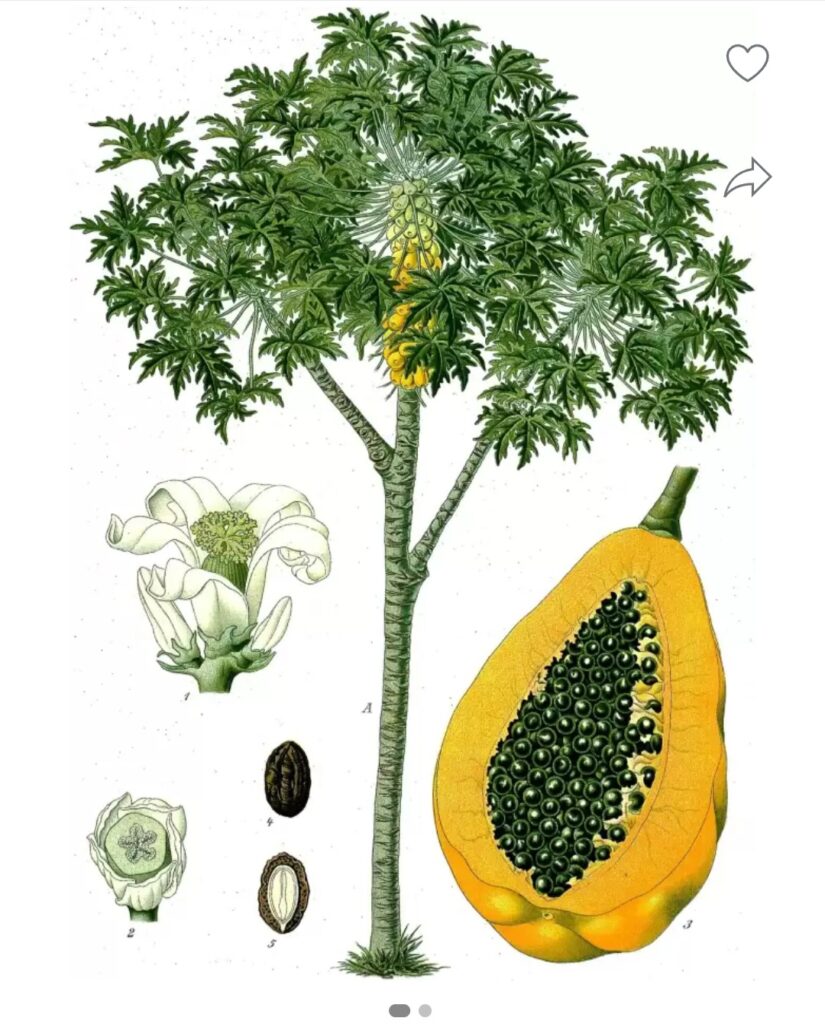
Papayas a fruit crop originate from Central America where the indigenes ate papayas and used them for medicinal purposes. In the 1500s and 1600s, Spanish and Portuguese colonizers brought the seeds to other tropical areas of the globe, including the African countries, Philippines and India.
Papaya belongs to the family Caricaceae, a small family of plants that comprise only six genera. The genus Carica L., intern comprises about 22 species that grow throughout the tropical and subtropical regions of the world. They can be characterise as a poorly branched trees or shrubs as described for Carica papaya.
Papayas grow best where there is plentiful rainfall but little long-term flooding. Freezing temperatures may damage a papaya crop.
Today, Hawaii, the Philippines, India, Ceylon, Australia, and tropical regions in Africa are the top papaya-producing regions. Smaller papaya-farming operations still exist in Central and South America.
Papaya is called by many different names all over the globe. In Australia, it’s called a pawpaw. In southern Asia, it’s sometimes called a kepaya, lapaya, or tapaya. Its name in French is sometimes “figueir des iles,” or fig of the islands. Some Spanish names for papaya include “melon zapote,” “fruta bomba,” or “mamona.” In Nigeria, the Yoruba tribe calls it porpor.
But the major common name for papaya plant and fruits is ‘pawpaw’.
DESCRIPTION
The papaya plant is considered as an herbaceous perennial tree.
Papaya has the potential to grow up to a height of between 2 to 10 m, and can reach maturity within a year. As it grows very fast, its economic life is also short and is around 3–4 years.
THE TREE: The papaya has an appearance of a tree but can also be refered to as a shrub. It has a cylindrical single stem which is hallow at the middle with spongy-fibrous tissues. The papaya tree hardly branch. Branching can only occurs when the main shoot is damaged/cut or the plant reaches to maturity, thereby new branches start appearing from the lower-end of the stem.
THE LEAVES: The leaves are large, lobed or palmated. The leaves appear in alternate fashion at the apical end of the shoot leaving the stem in the middle to lower region free from leaves with the leaves scares very conspicuous.
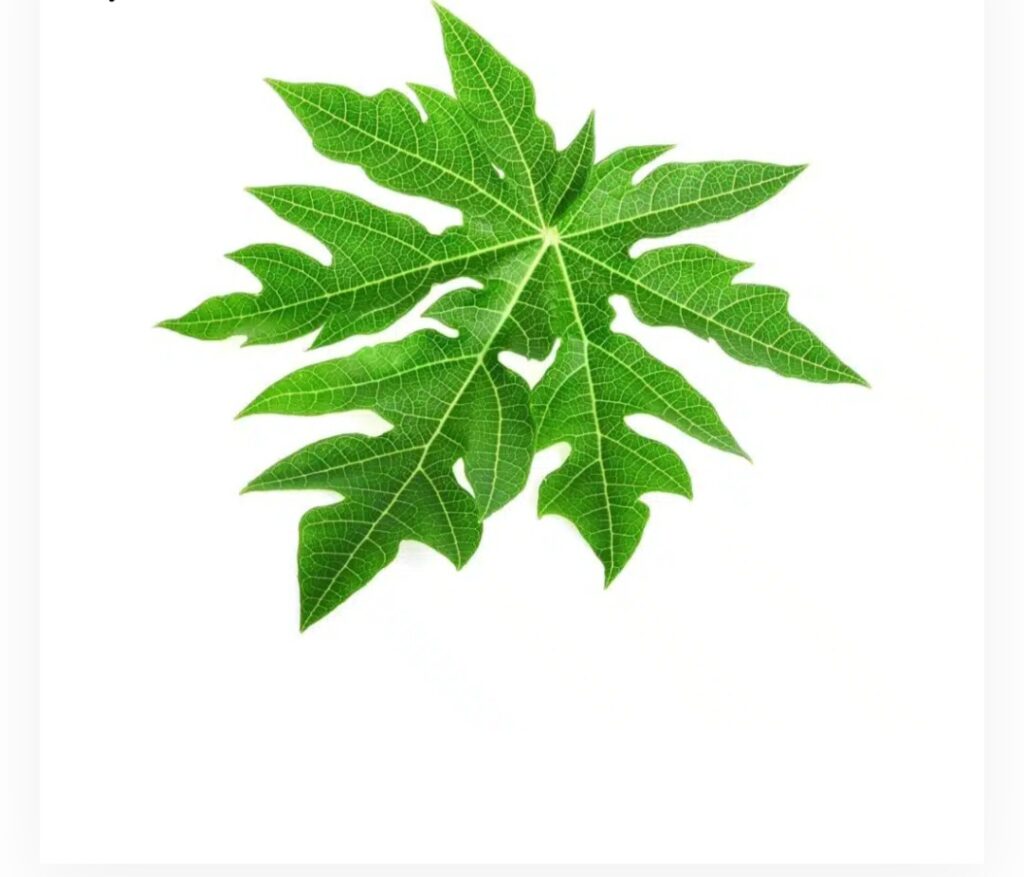
THE FLOWERS: The papaya tree is polygamous in nature, a behaviour that is governed not only by genetics but also the environment such as temperature, draught or a variety of other climatic conditions.
Papaya tree can produce only a male (staminate), or only female (pistillate) or hermaphroditic (bisexual) flowers; or in the latter case even a tendency to either a female of male sex could manifests.
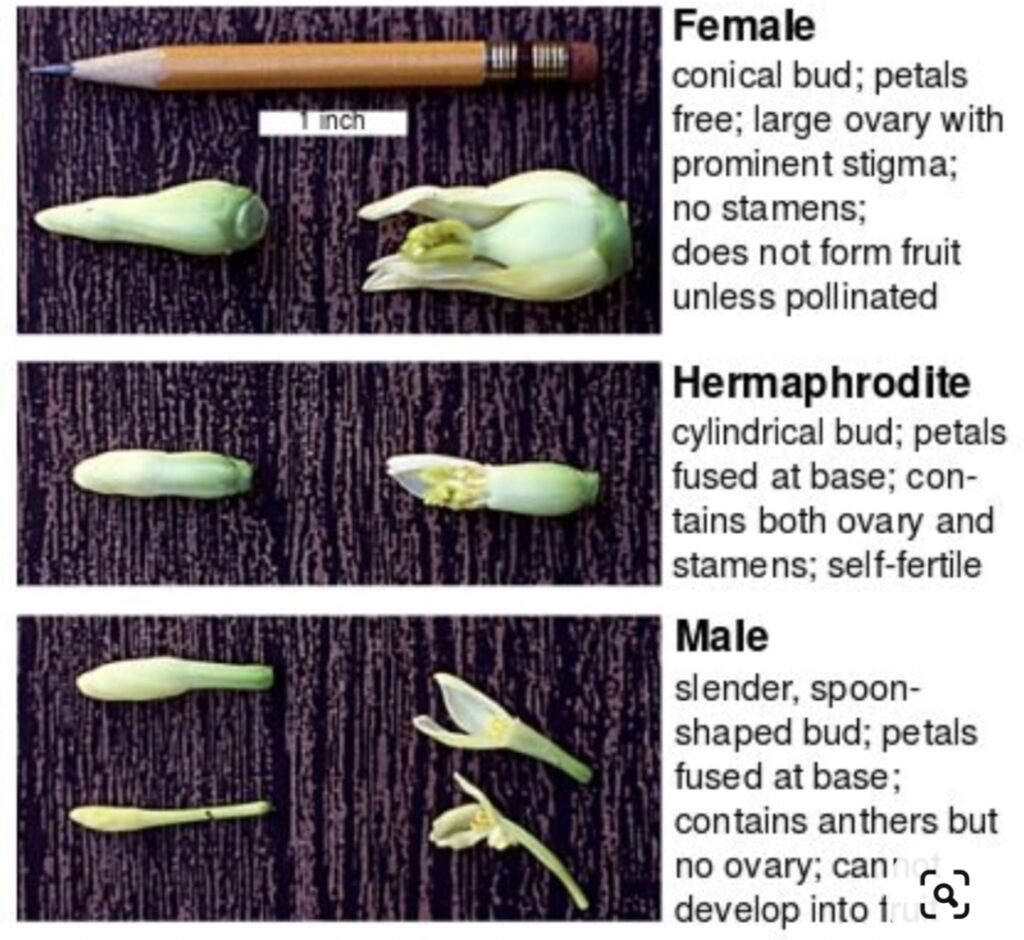
The Female and bisexual flowers are waxy, ivory white, and borne on short penducles in leaf axils, along the main stem. Flowers are solitary or small cymes of 3 individuals. Ovary position is superior. Prior to opening, bisexual flowers are tubular, while female flowers are pear shaped. Since, bisexual plants produce the most desirable fruit and are self–pollinating, they are preferred over female or male plants. A male papaya is distinguished by the smaller flowers borne on long stalks. They are unfruitful. Female flowers of papaya are pear shaped when unopened whereas, bisexual flowers are cylindrical”. Papaya start flowering between 5–8 months after planting. And these flowers develop to form the fruit.
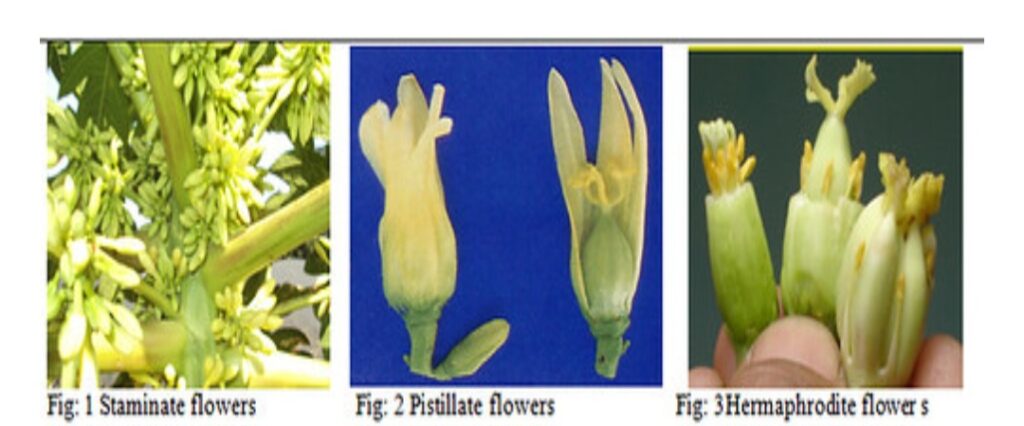
THE FRUIT: The papaya fruit are produced from the fertilized ovule which yield in abundance based on the number of fertilized flowers.. The papaya fruit is composed of the skin, pulp and seeds which vary in composition depending on varieties or cultivars. The seeds could vary between 5% and 9%; skin 12–25% and pulp from 70% to 80%. The composition of the fruits could also vary depending on ripening state, with immature ones, for example, producing large amount of latex.
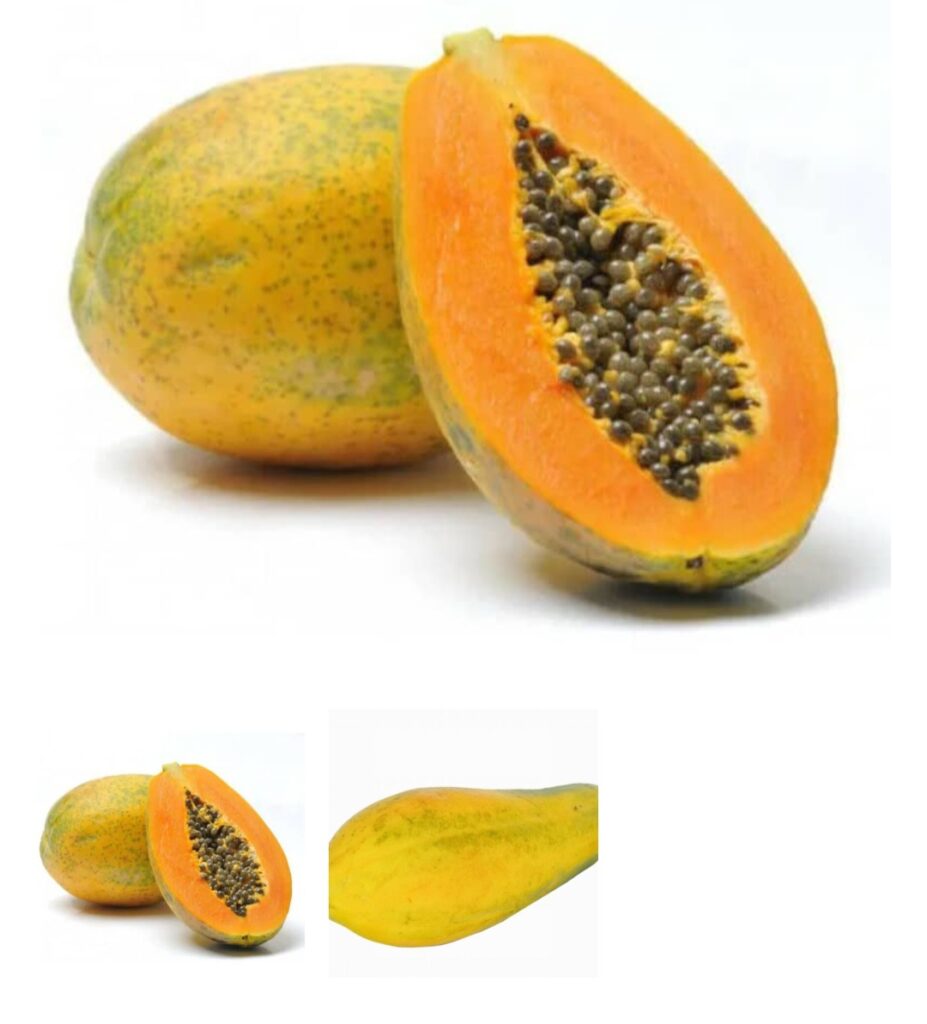
When the fruit ripens, the colour changes to light yellow and produce aroma. The pulp changes colour from white to orange or red. The skin becomes softer to be peeled.
PAPAYA FRUIT RIPENING
Fruit size of papaya do vary from less than 0.5 kg to 3kg. The fruit is mainly consumed fresh when ripened after harvest. Ripening is judged by the approximate percentage of yellowness on its skin, and more accurately by measuring its total soluble solids (TSS) contents with a refractometer. Firmness can also be used to judge ripening. This can be determined by touch or by a texture-measuring device. The firmness is related to the biochemical changes in three fractions of pectins in papayas, and is not a very accurate index of ripeness.
PAPAYA VARIETIES
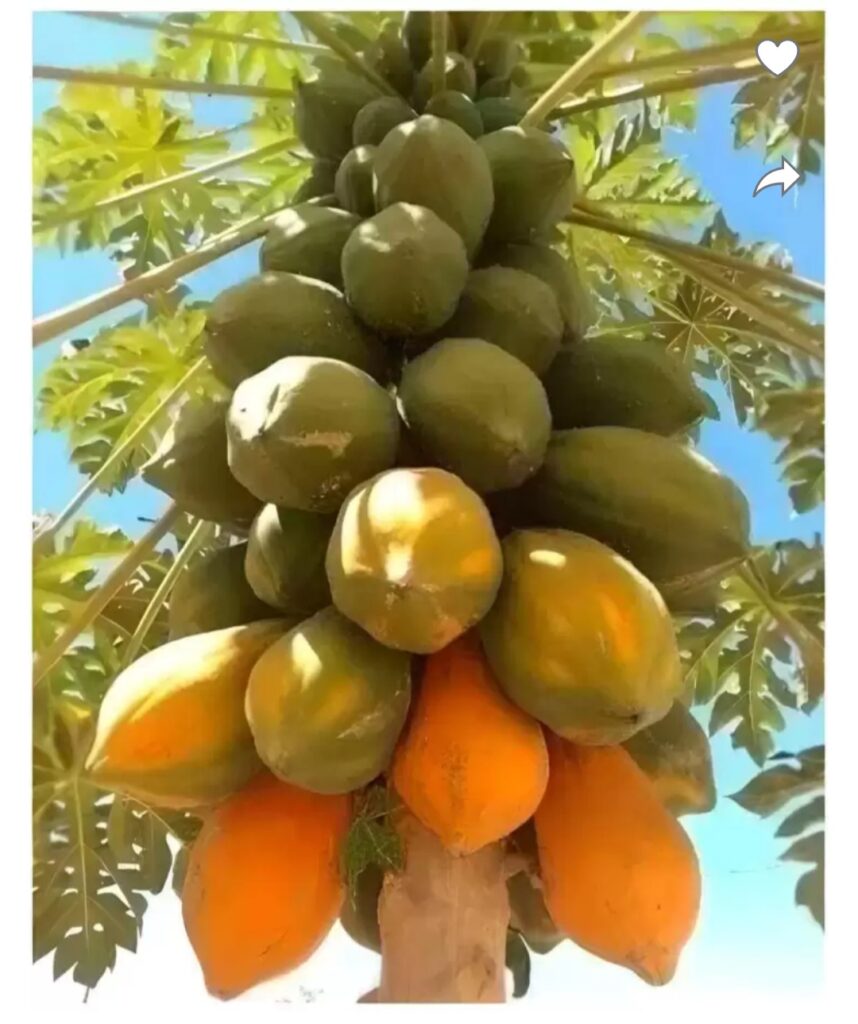
There are many varieties of papaya in the market, they including:
Kapaho solo (also known as puna solo)
Waimanolo
Higgins
Wilder
Hortus gold
Honey gold
Bettina
Improved Peterson
Sunnybank
Guinea gold
Coorg honeydew
Washington
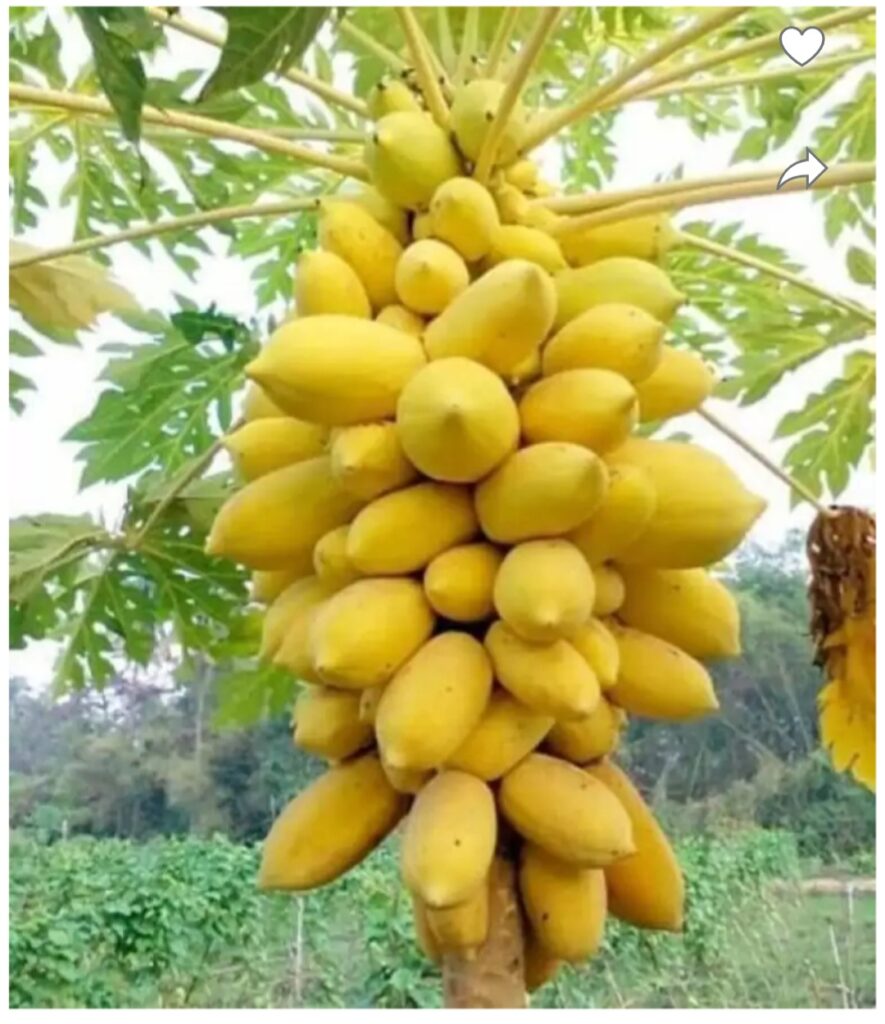
BENEFITS OF PAPAYA
1. Green papayas can be consumed when peeled or mixed in as a salad or in soups, which are quite popular in South-east Asia.
2. PROTECTION AGAINST HEART DISEASE: Papayas contain high levels of antioxidants such as vitamin A, vitamin C, and vitamin E. Diets high in antioxidants may reduce the risk of heart disease. The antioxidants prevent the oxidation of cholesterol. When cholesterol oxidizes, it may not create blockages that lead to heart disease.
3. Papaya is a delicious fruit. A good source of nutrients such as its high content of vitamins A, B, and C.
4. It contains proteolytic enzymes, such as papain and chymopapain and also have antibacterial, antifungal, and antiviral properties.
5. Papayas have gained popularity as a natural home treatment, and for their use in skin and hair products.
6. WRINKLE REDUCTION:
Papaya is rich in antioxidants, such as lycopene, that may defend against the visible signs of aging caused by free radicals. The antioxidants can help fight free radical damage which may help make the skin remain smooth and youthful.

7. Papaya may also help improve the elasticity of the skin. This improvement in skin elasticity could minimize the appearance of wrinkles.
8. A mixture of antioxidants including vitamin C and lycopene can help reduce the depth of facial wrinkles.
9. ACNE CONTROL:
The enzymes papain and chymopapain in papaya can decrease inflammation. The protein-dissolving papain can be found in many exfoliating products. These products help reduce acne by removing dead skin cells that can clog pores.
10. Papain can also remove damaged keratin that can build up on the skin and form small bumps. papain is also a treatment for scarring.
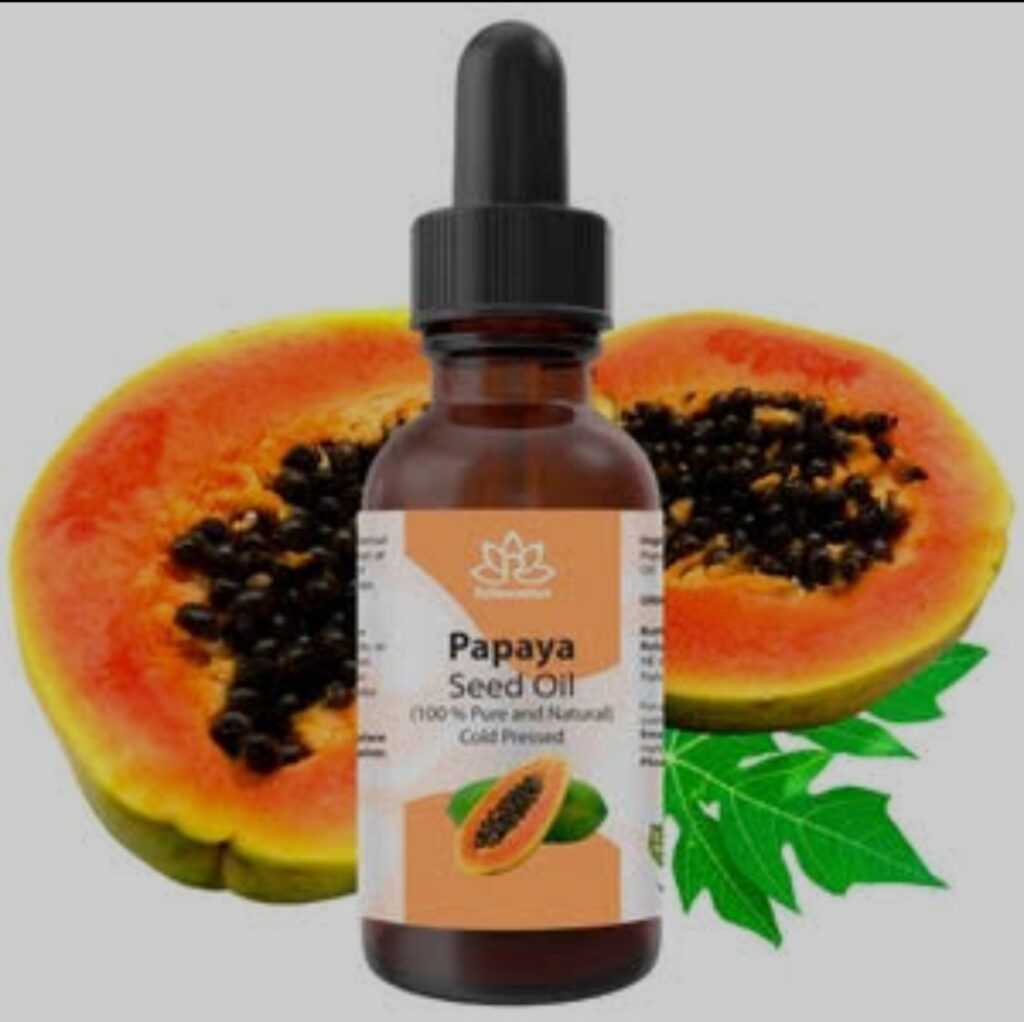
11. Retinol found in papaya is a topical form of vitamin A, can help treat and prevent inflammatory acne lesions.
12. MELASMA TREATMENT:
Papaya is a popular remedy for melasma. Studies have shown that the enzymes, beta-carotene, vitamins, and phytochemicals in papaya have skin lightening properties.
13. Daily application of cold-pressed papaya seed oil may help lighten dark spots.
14. HAIR CONDITIONING: the vitamin A in papaya can have positive effects on hair by helping the scalp produce sebum which nourishes, strengthens, and protects the hair.
15. HAIR GROWTH:
Studies have shown that compounds in papaya, including lycopene, are “a potent hair growth stimulating compound.”
16. DANDRUFF PREVENTION:
One of the main causes of dandruff is a yeast-like fungus known as malassezia. studies had shown that the antifungal properties of papaya seeds can assist in both controlling and preventing dandruff.
17. WEIGHT LOSS;
Eating papaya on an empty stomach can help with weight loss, improve heart health, enhance skin glow, ease constipation, and reduce cancer risks. However, cautions include avoiding excessive consumption of green papaya due to potential uterine contractions and monitoring for allergic condition.
18. LOW IN CALORIES :Papaya is a low-calorie fruit that is an excellent source of fiber, calcium, magnesium, potassium, and vitamins like A, C, E, and K. Those on a weight-loss regimen may find this fruit particularly beneficial due to its fiber content and low-calorie count.
19. REGULATION OF BLOOD SUGAR LEVEL
The nutrients in papaya can help normalize cholesterol levels and improve blood flow, reducing the risk of heart attacks and strokes. Papaya, with its low sugar content and high fiber, helps in regulating blood sugar levels. This is beneficial for diabetics and prevents hypertension by maintaining stable blood sugar levels. The papain enzyme in papaya acts as a natural pain reliever and helps control inflammation through cytokine production.
20. PREVENTS CANCER: Antioxidants in papaya, such as lycopene, inhibit cancer cell growth and reduce oxidative stress, lowering cancer risks. In addition, papaya is amazing for women’s health. Papaya’s carotene can stimulate the uterus and help regulate the menstrual cycle, reducing period cramps and promoting regularity.
SIDE EFFECTS OF EATING PAPAYA
1. There are certain side effects to consider when consuming papaya. One should be cautious when consuming green or semi-ripe papaya, as it contains high levels of latex. This concentrated form of latex may induce uterine contractions, which can lead to unplanned abortion, particularly in pregnant women.
2. Excessive consumption may damage the esophageal lining and cause allergic reactions due to its latex content.
3. People with low blood pressure and those prone to food allergies should be cautious.
4. Papaya seeds is known to reduce sperm count, therefore, should also be consumed with care.
PAPAYA SAP (PAPAIN)
When shallow cuts are made on the surface of fully grown unripe fruits of papaya, a milky sap or latex oozes out that can be collected, dried, and termed “crude papain.”The Papaya sap, also known as latex, contains the papain, an enzyme that may help with wound healing, pain, and inflammation. It is a protease, meaning it helps break down proteins but differs from other proteolytic enzymes (proteases).
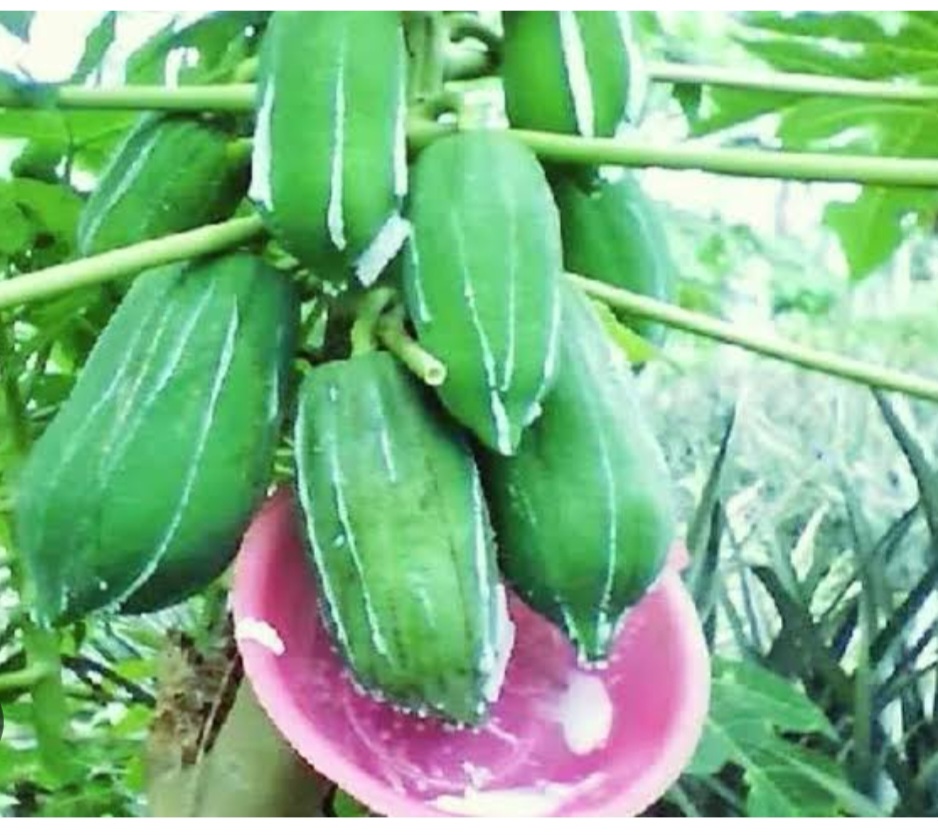
OTHER USES OF PAPAYA SAP
1. Papaya sap is used in folk medicine for many conditions, including psoriasis, ringworm, and indigestion.
2. WOUND HEALING : Papain may help heal wounds ( It contains substances that help fight infection), skin ulcers, and other skin conditions. Research had backed it up that papain may be used as a natural remedy for skin ulcers, wounds, and other skin conditions.
3. Papain-containing dressings may reduce infection, dying tissue, and hospitalization time for people with diabetic foot ulcers
4. Papain-containing gels may help wounds heal in rats. For example, a 2017 animal studyTrusted Source found a gel containing 3% papain led to better wound healing in rats than a placebo gel. Another 2019 animal study confirmed these findings.
5. PAIN AND INFLAMMATION : Papain may help ease acute pain, such as from burns or bruises
6. Papain may help with chronic inflammatory conditions such as arthritis and asthma
7. Papaya sap may be used as an antiseptic
8. Papaya sap may be used to treat psoriasis and ringworm
9. Papaya sap may be used to treat indigestion
10. Papain has many industrial uses, as well as milk-clotting (rennet) and protein-digesting properties.
11. Nearly 80% of American beer is treated with papain, which allows the beer to remain clear upon cooling.
12. Papain is commonly used commercially in meat tenderizers and chewing gums.
13. Cosmetically, papain is an ingredient used in some toothpastes, shampoos, and facial creams.
14. People also use papain for dental cavities, shingles, parasite infections, jellyfish stings, and many other conditions. But no good scientific evidence is available to support these uses.
15. Papain is also being studied in various ways as an ingredient in human wound dressing applications. For example, a 2017 study found that using dressings containing papain helped lower the amount of dying tissue, reduce the incidence of infection, and lower hospitalization time in people with diabetic foot ulcers.Another 2023 study compared different types of wound dressings for ulcers and also found greater effectiveness in various formulations containing papain extract.
16. It may help prevent obesity. Researches carried out on some animals had reported that papain can help reduce the progression of weight gain by lowering the accumulation of body fat and blood fat.
17. Papain supplements, or taking high doses of papain, may cause: throat irritation or damage, esophageal perforation, stomach irritationand allergic reaction.
18. Papain may lower blood sugar. Use with caution as a diabetes patient, hypoglycemia, or the use of medications or natural remedies that lower blood sugar.
19. Papain may increase bleeding risk in human. Therefore papain should not be used if taking blood thinners or have a blood clotting disorder. Also note that papain should not be consumed two weeks prior to surgery.
20. Pregnant or nursing females assigned at birth (FAABs), or those planning to become pregnant, can use papain supplements. That is because eating papaya may cause fetal poisoning or birth defects when consumed in large amounts.
SIDE EFFECTS OF PAPAIN
1. Papain is commonly consumed in foods or in medicines. It is safe when taken as medicine in doses up to 1200 mg daily for up to 9 weeks. But taking large amounts of papain is possibly unsafe. Very large doses might cause severe throat and stomach damage.
2. Application of raw papain or raw papaya fruit to the skin is possibly unsafe. Skin contact with raw papain can cause irritation and skinblisters.
3. During pregnancy, consuming papain is possibly unsafe. It might cause birth defects or miscarriage.
4. People allergic to fig and kiwi fruits might also be allergic to papain. The Food and Drug Administration (FDA)Trusted Source has also ordered companies to stop marketing unapproved topical papain products due to some people experiencing a life threatening allergic reaction upon use. Note that eating ripe papaya is considered safe. It is only if unripe papaya are eaten before such a person can be exposed to papain.
PAPAYA FARMING
Papaya farming involves growing the tropical fruit in the right conditions of soil, climate, and water:
CLIMATE
Papaya grows best in warm to hot climates with temperatures between 20–35°C. It is sensitive to frost and strong winds.
SOIL
Papaya grows best in well-drained, light, sandy loam soil with a pH of 5.5–6.7 and lots of organic matter. The soil should not be sticky or calcareous.
RAINFALL
Papaya needs adequate irrigation to prevent drought and frost damage. It does best with an even distribution of annual rainfall of over 1000 mm.
PLANTING
Papaya is usually propagated by seed, and the seeds should be treated with a fungicide to control diseases.
It can also be propagated by tissue culture. The seed rate is 250-300 g./ha. The seedlings can be raised in nursery beds 3m. long, 1m. wide and 10 cm high as well as in pots or polythene bags. The seeds after being treated with fungicides are sown 1 cm. deep in rows 10 cm apart and covered with fine compost or leaf mould. Light irrigation is provided during the morning hours. The nursery beds are covered with polythene sheets or dry paddy straw to protect the seedlings. About 15-20 cm. ( about 45–60 days) tall seedlings are chosen for transplanting.
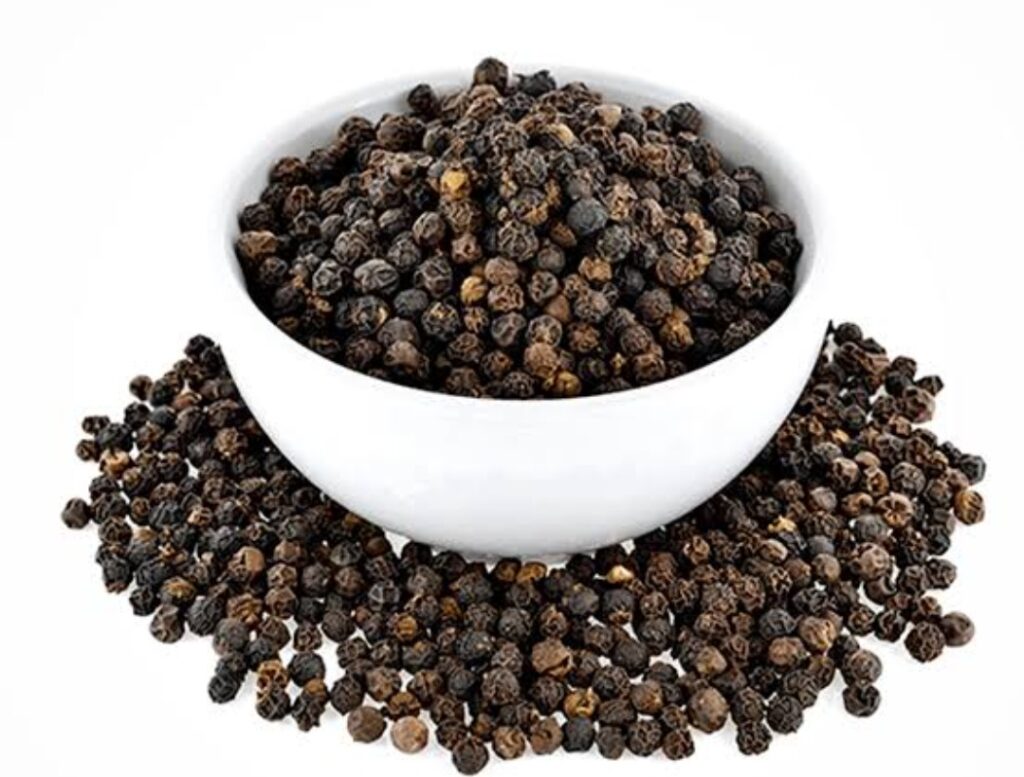
PLANTING SEASON:
Papaya is planted around February-March, June-July and between October-November .
SPACING:
A spacing of 1.8 x 1.8 m. is normally followed. However higher density cultivation with spacing of 1.5 x 1.5 m./ha enhances the returns to the farmer and is recommended.
FERTILIZING
Papaya plant needs heavy doses of manures and fertilizers. Apart from the basal dose of manures ( at 10 kg./plant) applied in the pits,
the general recommendation is 200:200:400 gm/plant/year of NPK fertilizer is required. Chlorine-free fertilizers should be used because papaya is sensitive to chlorine. Also, micro-nutrients should be applied inform of ZnSO4 (0.5%) and H2 BO3 (0.1%). They are needed inorder to increase growth and yield characters.
THINNING:
In dioecious varieties, all male plants should be removed except for one for every 10–12 female plants. Male plants flower earlier and can be identified by their long flowering stalks.
WEEDING:
Weeding can be done by hoeing at the first year to check weed growth. This should be done on regular basis especially around the plants. Also, pre-emergence herbicide can be applied two months after transplanting for effective control of weeds for a period of four months. Earthing up should also be done before or after the onset of monsoon to avoid water-logging and also to help the plants to stand erect.
INTER-CROPPING:
Papaya can be intercropped with leguminous crops followed by non-leguminous crops. Also, shallow rooted crops can be intercropped, followed by deep rooted crops. No intercrops should be done after the onset of flowering stage.
PAPAYA PESTS AND DISEASES
INSECT PESTS
The insect pests mostly observed in papaya plantation are fruit flies (Bactrocera cucurbitae), grasshopper (Poekilocerus pictus), aphids (Aphis gossypii), red spider mite (Tetranychus cinnabarinus), stem borer (Dasyses rugosellus) and grey weevil (Myllocerus viridans). In all cases the infected parts need to be destroyed.
APHIDS:
DAMAGE SYMPTOMS: They suck sap from leaves and cause leaf curling and distortion. Also causes premature drop of fruits. And they are vector for papaya ringspot virus
CONTROL: Remove and destroy damaged parts of the plant
.Use yellow sticky trap
.Spray Neem extract 0.3% at 2.5 – 3 ml/lit water. Also Chemical control with insecticides can be done.
WHITEFLY :
DAMAGE SYMPTOMS: Yellowing, downward curling, and crinkling of leaves (vector for papaya leaf curl virus).
Causes shedding of leaves
Sooty mold development on leaf surface due to honeydew secretion
CONTROL: Removal of alternate hosts, maintain field sanitation, Use yellow sticky trap, Spray Neem oil at 1 – 2 ml/lit water and spray insecticides .
RED SPIDER MITE :
DAMAGE SYMPTOMS: The presence of white or yellowish speckles on the leaf,
Webbing of affected leaf surface and causes scaring on fruits.
CONTROL: Spray Bio-acaricide at 1 – 2 ml/liter water or insecticides.
ROOT-KNOT NEMATODE :
DAMAGE SYMPTOMS: Yellowing and shedding of leaves, premature drop of affected fruits, presence of galls on roots
CONTROL: Select seedlings without root galls for transplanting, crop rotation,
Mahua cakes can be applied to control nematodes.
Mix well-decomposed compost with 2 kg of Multiplex safe root and broadcast in the field. Also, insecticides can be sprayed.
FRUIT FLY :
DAMAGE SYMPTOMS: The larvae feed on the internal portion of semi-ripe fruits by puncturing, presence of decayed patches and oozing of fluids on affected fruits, infected fruits turn yellow and fall prematurely
CONTROL: Dispose off the dropped-infested fruits,
Summer plowing to destroy pupa, Use fruit fly trap . Also, insecticides can be sprayed.
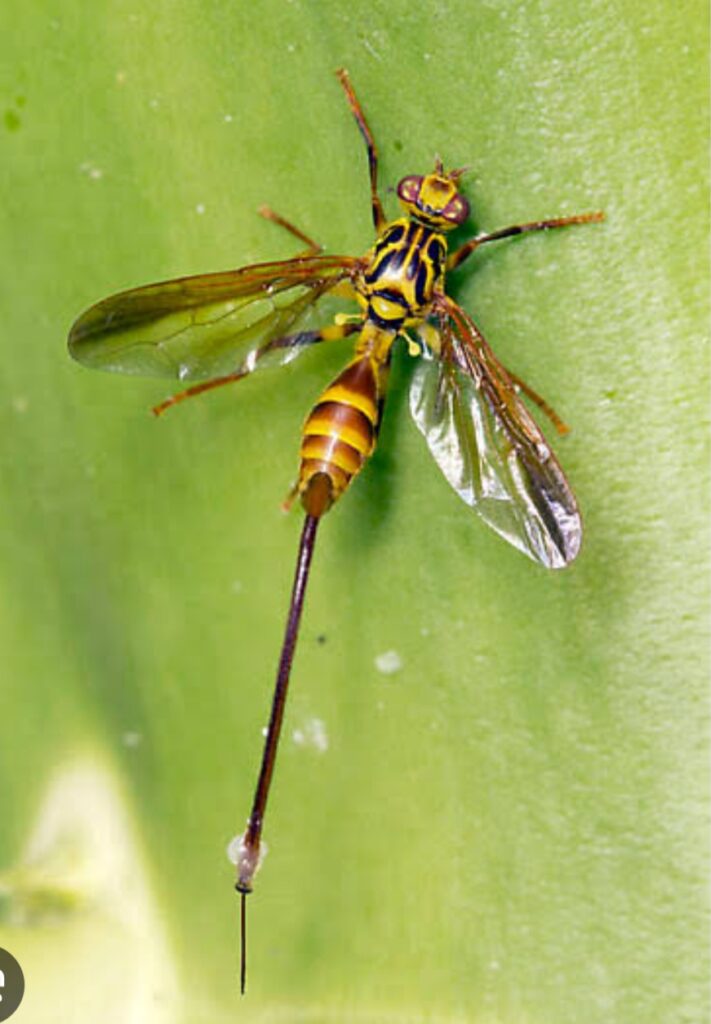
MEALYBUG :
DAMAGE SYMPTOMS: Presence of white cottony masses on leaf, stem, branches, and fruits,
Infected portions become shiny and sticky due to honeydew secretion which causes sooty mold development.
CONTROL: Uproot the infested plants, keep the field weed-free
Spray solution of Sarvodaya soap to control mealy bugs and spray insecticides.
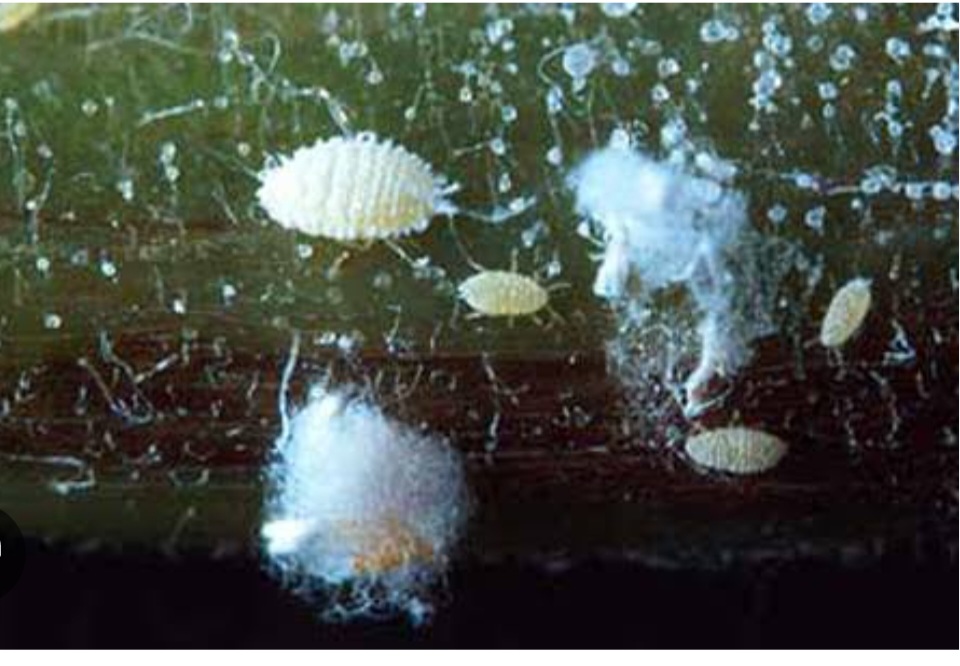
DISEASES
The main diseases reported are powdery mildew (Oidium caricae), anthracnose (Colletotrichum gloeosporioides), damping off and stem rot.
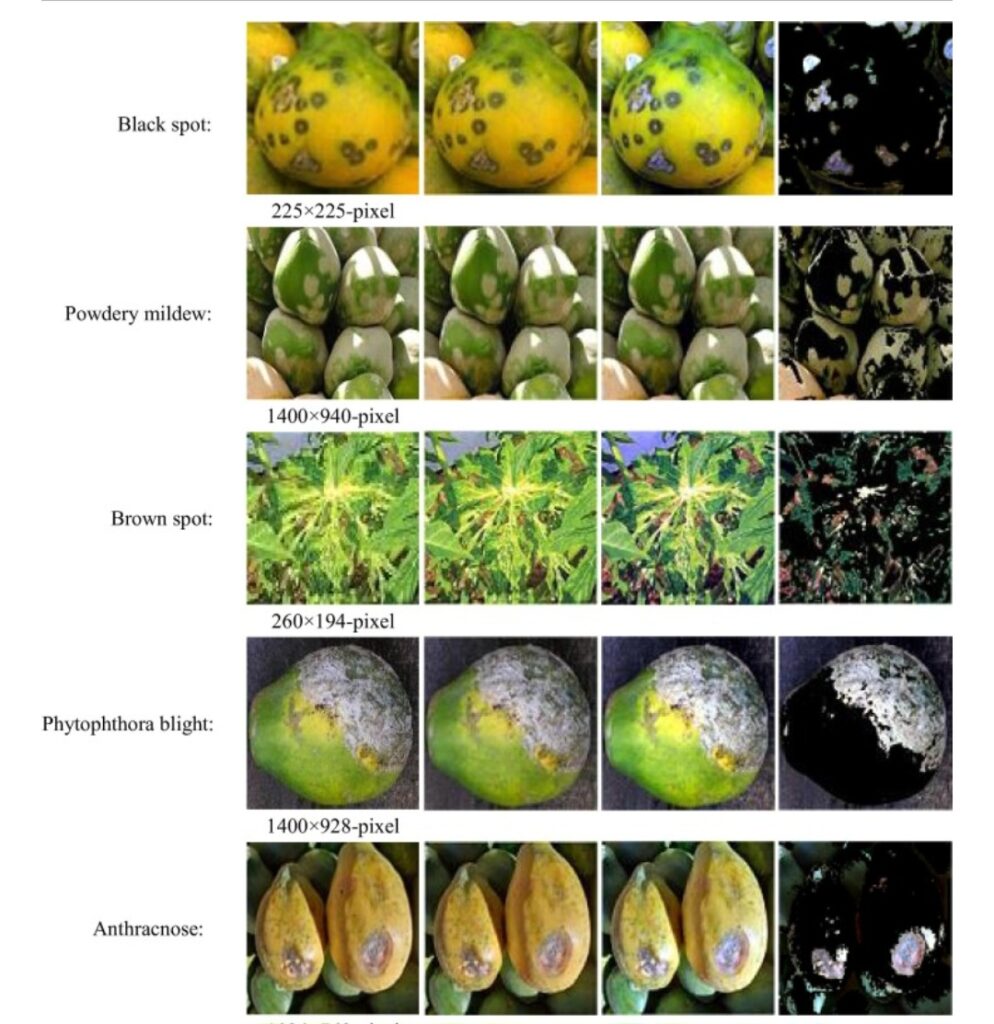
DAMPING OFF
It is a fungal disease and mostly common in nursery beds, causing the death of seedlings. The stem may start to rot at the soil line. Infected seedlings may wilt.
TREATMENT: Treat 1 kg seeds with 10 gm of Pseudomonas fluorescens mixed in 10 ml of water.
Also, Spray Fungicide or Matco Fungicide.
POWDERY MILDEW : It is a fungal disease that results in symptoms such as
White or grayish powdery growth on the upper leaf surface, flower stalk, and fruits
Severely infected leaves turn yellow or brown, curl, dry up, droop, and fall off
TREATMENT: Spray Pseudomonas fluorescence at 2.5 ml/lit water.
Spray fermented buttermilk (1:3 ratio of buttermilk & water) twice or thrice with 10 days interval. Also, spray fungicides.
ANTHRACNOSE
Affects leaves, flowers, and fruits resulting in drop-off
Small, black, or brown circular spots appear on leaves.
Infected fruits may develop dark, sunken lesions later covered with pinkish, slimy spore mass.
Withering and defoliation of leaves may occur.
TREATMENT: Spray fungicide.Fungicide.
PAPAYA RINGSPOT VIRUS
Vector: Aphids
Transmission: Sap, grafts
Plants show symptoms of d
downward and inward curling of leaf margin, leaf distortion .Mosaic pattern of light and dark green areas on leaves. The presence of concentric circular rings on the fruit surface
TREATMENT AND CONTROL: Do not grow cucurbits around papaya field but plant sorghum or maize as a barrier crop. Also, agrochemicals like Geolife no virus, VC 100 etc can be sprayed on plants. Also, control vector aphids.
PAPAYA LEAF CURL
Vector: Whitefly
Causes curling and crinkling of leaves. Downward and inward curling of leaf margin.
Affected leaves become brittle, leathery, and distorted
TEATMENT AND CONTROL: Do not grow tomato, or tobacco plants near the field
Also, Spray agrochemicals like V-Bind Bio viricide , liquid Micronutrient which help to develop resistance to the disease. And control vector whitefly by spraying insecticides.
ALTERNARIA LEAF SPOT:
Symptoms include: Small, circular, or irregular brown spots with concentric rings surrounded by a yellow halo on the affected leaves.
Defoliation of affected leaves
Circular to oval black lesions appear on the fruit surface
TREATMENT: Spray fungicides.
HARVESTING
The economic life span of papaya trees is 3-4 years. Harvesting of papaya too early or too late might increase the risk of postharvest physiological disorders. The papaya tree starts flowering and sets fruits in about 6 – 7 months. The fruits become ready for harvesting in 10 – 11 months from planting. Fruit ripening is indicated by the change in fruit colour from green to yellowish green. Also, when the latex ceases to be milky and become watery, the fruits are suitable for harvesting. Harvesting should be done by hand using sharp knives.
The yield varies widely according to variety, soil, climate and management of the orchard. The yield of 75-100 tonnes /ha. is obtained in a season from a papaya orchard depending on spacing and cultural practices.
HARVESTING INDICES: Fruit colour changes from dark green to light green with a slight tinge of yellow at the apical end
AVERAGE YIELD: Average yield per plant: 30 – 50 kg . Average yield per acre: 12 – 16 tons (1st year); 6 – 8 tons (2nd year) . Yield varies with cultivar.
POST HARVEST MANAGEMENT
GRADING
Fruits are graded on the basis of their weight, size and colour.
STORAGE
Fruits are highly perishable in nature. They can be stored for a period of 1-3 weeks at a temperature of 10-130 C and 85-90% relative humidity.
PACKING
Bamboo baskets with banana leaves as lining material are used for carrying the produce from farm to local market.
